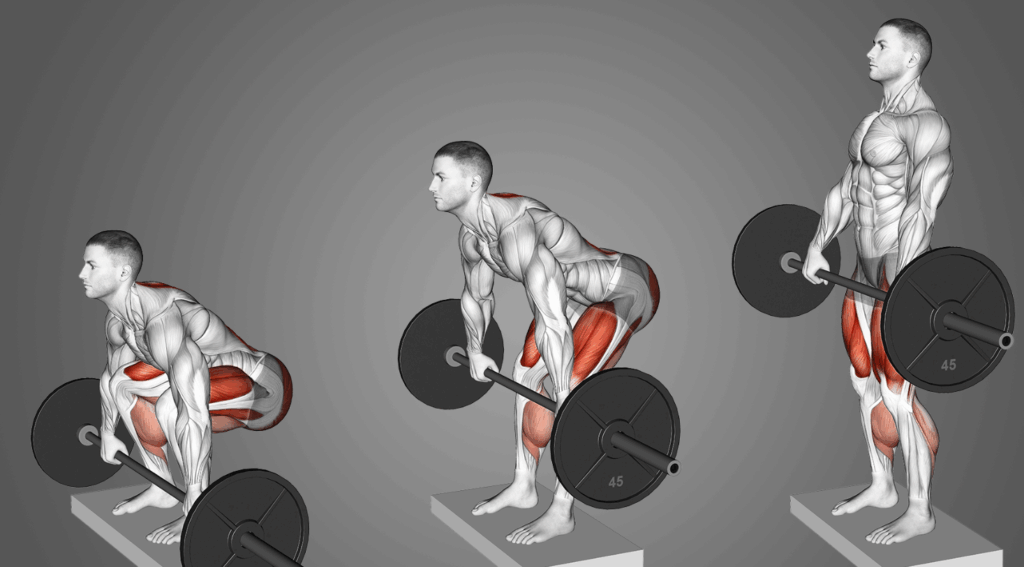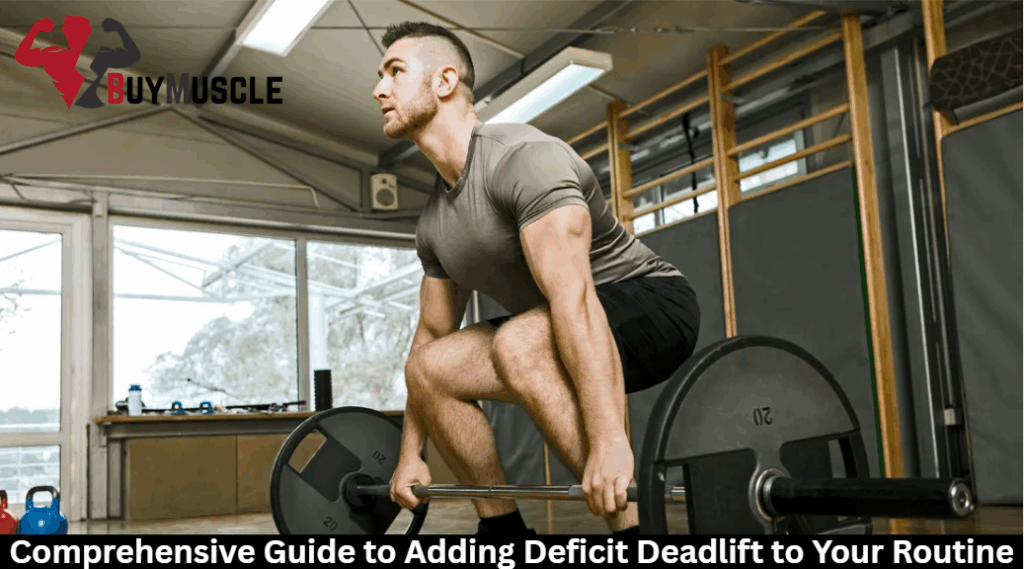You’ve mastered the conventional deadlift, but your lockout strength still lags. Sound familiar? The deficit deadlift might be the missing piece in your training puzzle. This advanced variation challenges your body in ways standard pulls can’t, forcing adaptations that translate to explosive power off the floor. Before you stack those plates and start pulling, there’s a strategic approach that separates smart programming from ego lifting.
What Is a Deficit Deadlift?
A deficit deadlift is a deadlift variation where you stand on an elevated surface, typically 1-4 inches high, while the barbell remains on the floor. This setup forces you to pull from a lower starting position, considerably increasing your range of motion compared to conventional deadlifts.
You’re fundamentally creating a deeper pull that challenges your posterior chain through extended time under tension. The deficit deadlift targets weaknesses in your starting position and builds explosive power off the floor.
You can create the deficit using weight plates, rubber mats, or dedicated pulling blocks. The height you choose depends on your mobility and training goals. Beginners should start with smaller deficits around 1-2 inches, while experienced lifters can work up to 4 inches.

Muscles Targeted and Key Benefits
Now that you understand what deficit deadlifts are and how to set them up, let’s examine which muscles they target and why they’re worth adding to your program. Deficit deadlifts primarily hammer your posterior chain, creating superior hamstring activation compared to conventional pulls. You’ll feel intense engagement in your glutes, hamstrings, and erector spinae throughout the extended range of motion.
The increased pulling distance forces your hamstrings to work harder from a stretched position, building exceptional glute and hamstring strength. Your traps and lats also get extra work maintaining upper back tightness through the longer pull. This variation particularly benefits lifters who struggle off the floor, as it develops the exact muscles and positions needed for a powerful start.

How to Perform a Deficit Deadlift Correctly
Step onto your elevated platform and position your feet hip-width apart, ensuring the barbell sits directly over your mid-foot. You’ll need to drop your hips lower than usual while maintaining a neutral spine. Keep your chest up and shoulders slightly ahead of the bar.
Drive through your heels as you initiate the pull, maintaining proper deadlift form throughout. Your back angle should stay consistent until the bar passes your knees. Don’t let your hips shoot up first. This common mistake turns the movement into a stiff-leg deadlift.
Among deadlift accessory exercises, deficit pulls demand exceptional mobility and control. Practice with lighter weights initially to perfect your technique. Focus on keeping the bar close to your body and finishing with strong hip extension at lockup.
How to Program Deficit Deadlifts into Your Routine
Once you’ve mastered the technique, you’ll need to integrate deficit deadlifts strategically into your training program. The key to programming deficit deadlifts into your routine lies in timing and volume.
During offseason training, you can perform deficit deadlifts weekly as your main pull or secondary movement. Use 3-5 sets of 3-6 reps at 70-85% of your conventional deadlift max. For peaking phases, reduce frequency to every other week, focusing on speed and technique rather than heavy loads.
The deadlift variation benefits include improved starting strength and positioning. Program them on your main deadlift day or as an accessory exercise. Allow 48-72 hours between heavy pulling sessions for recovery. Pair deficit deadlifts with complementary exercises like Romanian deadlifts or good mornings to maximize posterior chain development.
Deficit Deadlift vs Other Deadlift Variants
While deficit deadlifts excel at building strength from the floor, understanding how they compare to other deadlift variations helps you choose the right tool for your specific weaknesses.
The deficit vs conventional deadlift comparison reveals key differences:
- Deficits increase the range of motion and challenge your starting position
- Conventional pulls let you handle heavier loads with standard mechanics.
Among deadlift variations, snatch-grip deadlifts also extend the range of motion but emphasize upper back strength rather than leg drive. Block pulls work the opposite spectrum. They shorten the movement to target lockout strength. Romanian deadlifts isolate posterior chain development without floor contact.
Choose deficit deadlifts when you’re slow off the floor or need better positioning. Select block pulls for lockout issues, and snatch-grip for upper back weaknesses.

Modifications and Safety Considerations
Before jumping into deficit deadlifts, take a step back and check in with your body. How’s your mobility? Any past injuries, especially in the lower back? These factors matter. If you’re new to the lift, ease in with a small deficit, just 1 to 2 inches is enough to start. And if you’ve had back issues in the past, it’s best to skip this movement altogether or run it by a qualified coach first.
The key with deficit pulls is staying dialed in. You’ve got a longer range of motion here, which means more stress on your lower back. So your form needs to be locked down, especially that neutral spine. If you start to lose that positioning, lower the deficit, or stop right there. No ego lifting.
Make sure your warm-up includes mobility work for your hips and ankles. Deficit deadlifts are demanding, so do them early in your session when you’re fresh. Once a week is usually plenty. Keep an eye on your recovery, too. If you’re feeling beat up or sore for days, back off and give your body the rest it needs.
Frequently Asked Questions
Can I Use Deficit Deadlifts if I Have Long Arms?
Yes, you can use deficit deadlifts with long arms. They’ll challenge your positioning and strengthen your pull from the floor. You’ll need extra hip mobility since your longer arms already give you a mechanical advantage.
What Shoes Work Best for Deficit Deadlifts?
You’ll want flat-soled shoes with minimal cushioning for deficit deadlifts. Chuck Taylors, wrestling shoes, or deadlift slippers work great. Avoid running shoes – their thick soles reduce stability and make it harder to maintain proper form.
Will Deficit Deadlifts Increase My Conventional Deadlift Max?
Yes, deficit deadlifts can boost your conventional max by strengthening your weakest position – the bottom pull. You’ll develop more power off the floor and improve your starting mechanics, which typically translates to heavier conventional lifts.
Are Deficit Deadlifts Allowed in Powerlifting Competitions?
No, you can’t use deficit deadlifts in powerlifting competitions. Official meets only allow conventional and sumo deadlifts from the standard floor height. You’ll need to save deficit work for training to build your competition lifts.
Should I Use Straps When Performing Deficit Deadlifts?
You can use straps for deficit deadlifts if grip limits your training. They’ll help you focus on pulling mechanics and overload your posterior chain. However, train without straps occasionally to maintain grip strength for competition.








